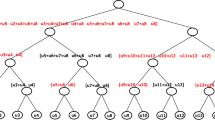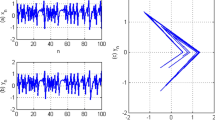Abstract
Interleaving is frequently used in digital communication and storage systems to improve the performance of forward error correcting codes. For turbo codes, an interleaver is an integral component and its proper design is crucial for good performance. Quadratic permutation polynomial (QPP) interleaver is a contention-free interleaver which is suitable for parallel turbo decoder implementation. This paper proposes a novel interleaver design, a variant of QPP interleaver, for turbo codes, which permutes a sequence of bits with the same statistical distribution as a conventional QPP interleaver and performs as well as or better than the conventional QPP. Proposed architecture has been simulated and synthesized using Xilinx and HDL Designer tools. Very large scale integration architecture for the proposed interleaver has been presented and analyzed for trade-off in terms of area, delay and power dissipation. Thermal power dissipation and device utilization have been computed for the proposed design using QuartusII (32-bit) tool. The paper also presents a comparison between the proposed variant of QPP interleaver and the conventional QPP interleaver.


















Similar content being viewed by others
Abbreviations
- 3GPP:
-
Third generation partnership project
- LTE:
-
Long-term evolution
- QPP:
-
Quadratic permutation polynomial
References
GPP TR 25.913 V7.3.0 (2006-03) Requirements for evolved UTRA (Release 7)
Jung, P., & Nasshan, N. (1994). Performance evaluation of turbo-codes for short frame transmission systems. Electronic Letters, 30(2), 111–113.
Sharma, S. (2012). A novel weighted multilevel space-time trellis coding scheme. Journal of Computers and Mathematics with Applications., 63(1), 280–287.
Jain, D., & Sharma, S. (2014). Adaptively grouped multilevel space-time trellis codes. Wireless Personal Communications: An International Journal, 74(2), 415–426.
Jain, D., & Sharma, S. (2014). Adaptively grouped multilevel space–time trellis codes combined with beam-forming and component code selection. Wireless Personal Communications, An International Journal, 77(4), 2549–2563.
Jain, D., & Sharma, S. (2014). A novel grouped multilevel dynamic space–time trellis coding scheme. International Journal of Communication Systems. doi:10.1002/dac.2754.
Sharma, S., Attri, S., & Chauhan, R. C. (2003). A Simplified and efficient implementation of FPGA based turbo decoder. In IEEE international proceedings of performance, computing, and communications conference (Vol. 2003, pp. 207–213).
Verma, S., & Kumar, S. (2014). High-performance VLSI architectures for turbo decoders with QPP interleaver. International Journal of Electronics. doi:10.1080/00207217.2014.917719.
Verma, S., & Sharma, S. (2011). An FPGA realization of simplified turbo decoder architecture. International Journal of the Physical Sciences, 6(10), 2338–2347.
Jung, P., & Nasshan, N. (1994). Dependence of the error performance of turbo-codes on the interleaver structure in short frame transmission systems. Electronic Letters, 30(4), 287–288.
Perez, L. C., Seghers, J., & Costello, D. J, Jr. (1996). A distance spectrum interpretation of turbo codes. IEEE Transaction on Information Theory, 42, 1698–1709.
Daneshgaran, F., & Mondin, M. (1997). On design of interleaver for turbo codes. In Proceedings CISS’97 (pp. 509–514). Baltimore, MD.
Dobkin, R. R., Peleg, M., & Ginosar, R. (2005). Parallel interleaver design and VLSI architecture for low-latency MAP turbo decoders. IEEE Transactions on Very Large Scale Integration (VLSI) Systems, 13(4), 427–438.
Khandani, A. K. (1999). Dynamic generation of good turbo-code interleavers. Waterloo, ON, Canada: Department of Electrical and Computer Engineering, University of Waterloo. Technical Report UW-E&CE99-02.
Andrews, K. S., Heegard, C., & Kozen, D. (1998). Interleaver design methods for turbo codes. In Proceedings IEEE international symposium information theory (ISIT’98) (p. 420). Cambridge, MA.
Crozier, S. N.(2000). New high-spread high-distance interleavers for turbo codes. In Proceedings 20th B. Symposium communications (pp. 3–7). Kingston, ON, Canada.
Barbulescu, A. S., & Pietrobon, S. S. (1994). Interleaver design for turbo codes. Electronics Letters, 30(25), 2107–2108.
Garello, R., Montorsi, G., Benedetto, S., & Cancellieri, G. (2001). Interleaver properties and their application to the trellis complexity analysis of turbo codes. IEEE Transactions on Communications, 49, 793–807.
Hokfelt, J., Edfors, O., & Maseng, T. (2001). A turbo code interleaver design criterion based on the performance of iterative decoding. IEEE Communications Letters, 5, 52–54.
Khandani, A. K. (1998). Group structure of turbo-codes. Electronics Letters, 34(2), 168–169.
Takeshita, O. Y., & Costello, Jr., D. J. (1998). New classes of algebraic interleavers for turbo-codes. In Proceedings IEEE international symposium information theory (ISIT’98) (p. 419). Cambridge, MA.
Hokfelt, J., Edfors, O., & Maseng, T. (1999). Interleaver design for turbo codes based on the performance of iterative decoding. In 1999 IEEE international conference on communications, 1999. ICC ‘99 (Vol. 1, pp. 93–97). Vancouver, BC.
Takeshita, O. Y., & Costello, Daniel J. (2000). New deterministic interleaver designs for turbo codes. IEEE Transactions on Information Theory, 46(6), 1988–2006.
Popovski, P., Kocarev, L., & Risteski, A. (2004). Design of flexible-length s-random interleaver for turbo codes. IEEE Communications Letters, 8(7), 461–463.
Kusume, K., & Bauch, G. (2006). Cyclically shifted multiple interleavers. In Proceedings IEEE global telecommunications conference (GLOBECOM 2006). San Francisco, California, USA.
Dobkin, R., Peleg, M., & Ginosar, R. (2005). Parallel interleaver design and VLSI architecture for low-latency MAP turbo decoders. IEEE Transaction on Very Large Scale Integration Systems, 13(4), 427–438.
Nimbalker, A., Blankenship, T. K., Classon, B., Fuja, T. E., & Costello, Jr. D. J. (2004). Contention-free interleavers. In Proceedings 2004 IEEE international symposium on information theory (p. 54). Chicago, IL.
Berrou, C., Kerouédan, S., Saouter, Y., Douillard, C., & Jézéquel, M. (2004). Designing good permutations for turbo codes: Towards a single model. In Proceedings international conference on communications (Vol. 1, pp. 341–345). Paris, France.
Giulietti, A., Van der Perre, L., & Strum, M. (2002). Parallel turbo coding interleavers: avoiding collisions in access to storage elements. IEEE Electronics Letters, 38(5), 232–234.
Blankenship, T. K., Classon, B., & Desai, V. (2002). High-throughput turbo decoding techniques for 4G.In Proceedings international conference 3G wireless and beyond (pp. 137–142). San Francisco, CA.
Sun, Y., & Cavallaro, J. R. (2011). Efficient hardware implementation of a highly-parallel 3GPP LTE/LTE-advance turbo decoder. Integration, The Very Large Scale Integration Journal, 44(4), 305–315.
Lee, S., Wang, C., & Wern-Ho, S. (2010). Architecture design of QPP interleaver for parallel turbo decoding. In Vehicular technology conference (VTC 2010-Spring), 2010 IEEE (Vol. 71, pp. 1–5).
Takeshita, O. Y. (2007). Permutation polynomial interleavers: An algebraic-geometric perspective. IEEE Transaction for Information Theory, 53(6), 2116–2132.
Nimbalker, A., Blankenship, Y., Classon, B., & Blankenship, T. K. (2008). ARP and QPP interleavers for LTE turbo coding. Wireless communications and networking conference, 2008. WCNC 2008. IEEE (pp. 1032–1037). Las Vegas, NV.
Trifina, L., Tarniceriu, D., & Munteanu, V. (2011). Improved QPP interleavers for LTE standard. 10th International symposium on signals, circuits and systems (ISSCS), 2011 (pp. 1–4).
Takeshita, O. Y. (2006). On maximum contention-free interleavers and permutation polynomials over integer rings. IEEE Transactions on Informations Theory, 52, 1249–1253.
Wang, G., Vosoughi, A., Shen, H. Cavallaro, J. R., & Guo, Y. (2013). Parallel interleaver architecture with new scheduling scheme for high throughput configurable turbo decoder, In 2013 IEEE international symposium on circuits and systems (ISCAS) (pp. 1340–1343).
Wang, G., et al. (2014). Parallel interleaver design for a high throughput HSPA+/LTE multi-standard turbo decoder. IEEE Transactions on Circuits and Systems I: Regular Papers, 61(5), 1376–1389.
Chi, C.-L. (2013). Quadratic permutation polynomial interleavers for LTE turbo coding. International Journal of Future Computer and Communication, 2(4), 364–367.
Sun, J., & Takeshita, O. Y. (2005). Interleavers for turbo codes using permutation polynomials over integer rings. IEEE Transactions on Information Theory, 51, 101–119.
Multiplexing and channel coding, 3GPP TS 36.212 version 8.4.0, September 2008.
Nimbalker, A., Blankenship, K. T., Classon, B., Fuja, T. E., & Costello, D. J. (2008). Contention- free interleavers for high-throughput turbo decoding. IEEE Transactions on Communications, 56(8), 1258–1267.
Author information
Authors and Affiliations
Corresponding author
Rights and permissions
About this article
Cite this article
Pasricha, S., Sharma, S. Novel Interleaver Design for Turbo Codes. Wireless Pers Commun 86, 727–749 (2016). https://doi.org/10.1007/s11277-015-2954-5
Published:
Issue Date:
DOI: https://doi.org/10.1007/s11277-015-2954-5




